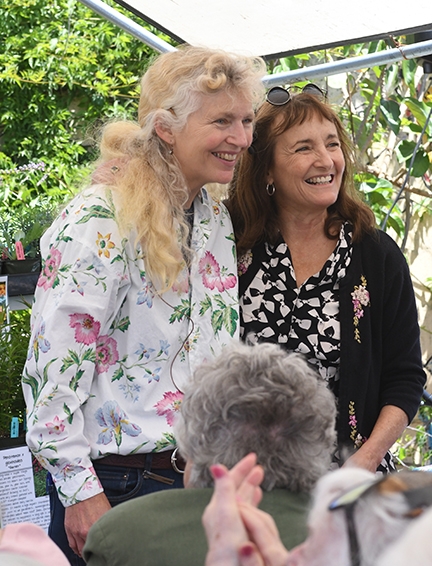
“I'd love to attract honey bees, bumble bees and other pollinators, but what can I do?" you ask. "Where do I start?"
So we asked world-class garden designer Kate Frey of Hopland, a two-time gold medal winner at the prestigious Chelsea Flower Show in London, co-founder of the American Garden School, and co-author of The Bee-Friendly Garden (with Professor Gretchen LeBuhn of San Francisco State University) for her advice.
Few people are as passionate about pollinators and pollinator gardens as Kate Frey.
We heard her speak at the Native Bees Workshop last September at the Hopland Research and Extension Center, Mendocino County, and we tagged along on her guided tour of her one-acre spectacular garden at her Hopland home, where she and husband Ben and assorted pets reside. We also heard her speak on "Gardening for Bees, Beauty and Diversity" May 14 at Annie's Annuals and Perennials, Richmond.
Kate is highly sought as a speaker, whether it be at sustainable landscape programs, gardening seminars, or at UC workshops. Among her affiliates: University of California entomologists Robbin Thorp, distinguished emeritus professor at UC Davis, and Professor Gordon Frankie of UC Berkeley. (Read what Frankie has to say about native bees.)
So, what to do first? Kate offers these tips:
- Create healthy gardens that require no pesticides by using the right plant, right place approach, add quality compost to all plants and irrigate adequately.
- Choose appropriate plants for your water, soils, exposure, climate, and if annuals, season!
- Think in terms of abundance, not minimalism. Plant at least a 3-x-3 foot area of each plant, or repeat the same plant throughout your garden. Each honey bee colony needs an estimated one-acre of flowers to support it.
- Goal: 12 months of bloom. Plants can be annuals, perennials, shrubs or trees.
- Make sure plants do offer floral resources, as many landscape plants don't.
- Have patches or repeated plants of the same flower. Honey bees practice floral constancy.
- Include water for honey bees
- Sunny spaces are the best.
- Provide bee-block nests and mulch-free nest sites for native bees.
All great advice! Indeed, we should think of pollinators as not mere "visitors," but permanent residents. Plant what they like and they will come. To ensure that they will stay stay, leave soil bare for ground-nesting bees, such as bumble bees. And don't forget those bee-block nests, or bee condos, for leafcutter bees and blue orchard bees.
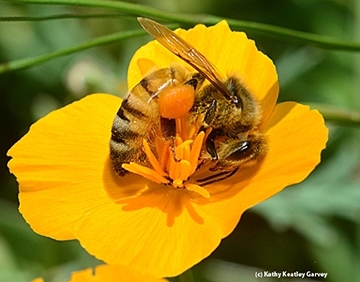
- Asclepias milkweeds, all
- Asters, Aster x frikartii 'Monch' A. ericoides ‘Monte Casino', A. laterifolius Lady in Black'
- Agastache, ‘Black Adder' ‘'Purple Haze' Rosy Giant' ‘Tutti Frutti' and many more
- Arbutus unedo, Strawberry tree
- Arctostaphylos, most Manzanita
- Calamentha nepetoides, Calamentha
- Ceanothus, all California lilac
- Epilobium, California fuchsia. There are many good cultivars
- Eriogonum fasciculatum, California buckwheat
- Gaillardia, Blanket flower
- Helianthus bolanderi, native shrubby sunflower
- Monardella villosa, Coyote mint
- Nepeta faassenii, all nepetas, Catmint
- Origanum, flowering oregano, all. Origanum 'Santa Cruz' and 'Bristol Cross' are good.
"Bee gardens make people happy," Kate Frey and Gretchen LeBuhn write in their book. "Whether you enjoy a brilliant chorus of saturated color, a tranquil sanctuary from the busy world, or a hardworking edible garden, there is a glorious, flower-filled bee garden waiting for you."
Yes, we all need a happy place. And so, too, do the pollinators.
Attached Images:
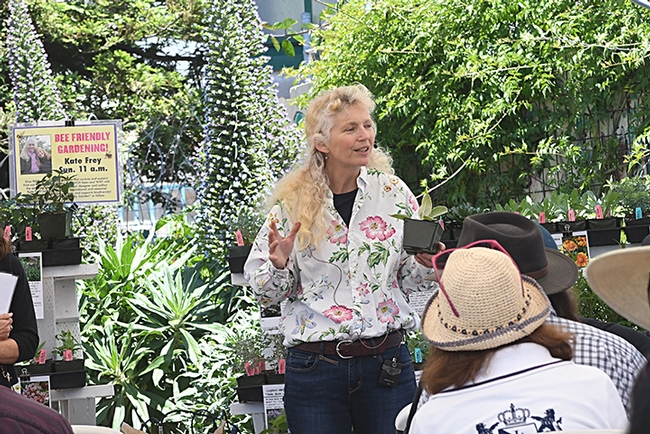
Award-winning garden designer, author and pollinator specialist Kate Frey addresses a recent crowd at Annie's Annuals and Perennials. Her topic: "Gardening for Bees, Beauty and Diversity." (Photo by Kathy Keatley Garvey)
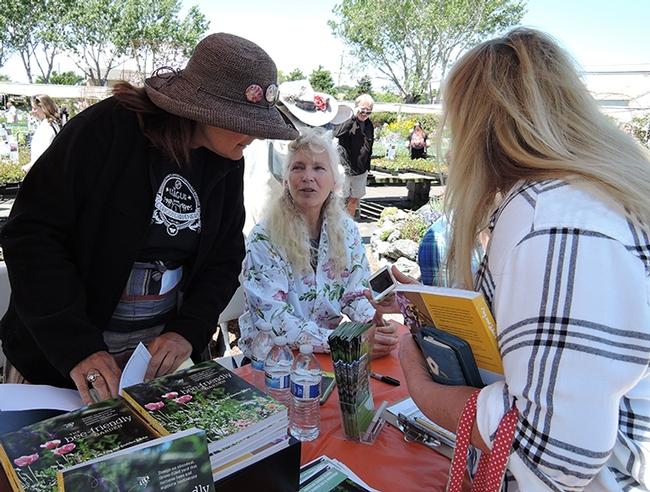
Following her talk at Annie's Annuals and Perennials, Richmond, Kate Frey (center) answers questions and signs copies of her book,"The Bee Friendly Garden" (co-authored with Professor Gretchen LeBuhn of San Francisco State University). (Photo by Kathy Keatley Garvey)
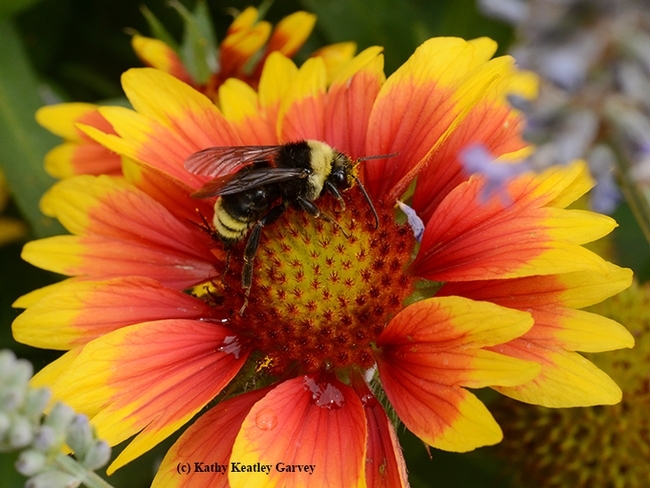
One of the pollinator plants that Kate Frey recommends is the blanket flower, Gaillardia. Here a bumble bee, Bombus californicus, gives its approval. (Photo by Kathy Keatley Garvey)
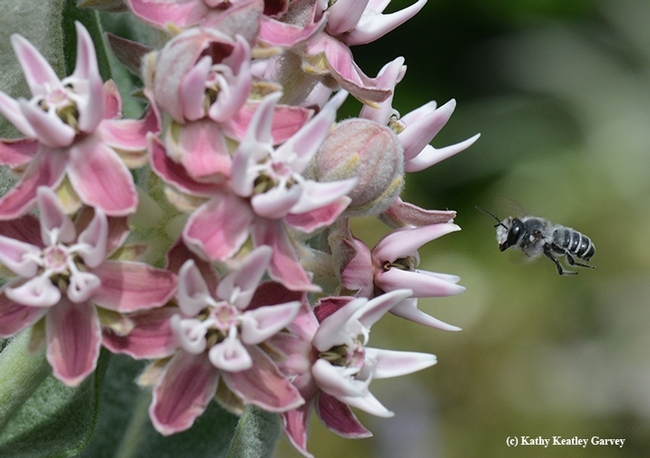
Milkweed as one of Kate Frey's favorite pollinator plants. It's not only the host plant of the monarch butterfly, but other insects like it, too, including this leafcutter bee. This species is Asclepias speciosa. (Photo by Kathy Keatley Garvey)
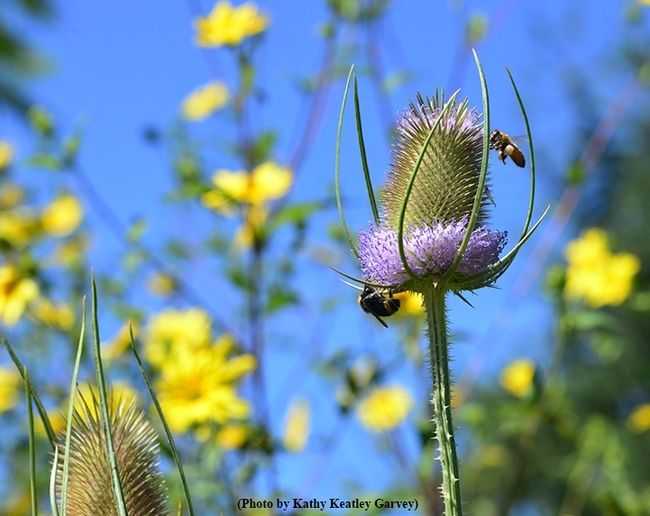
A bumble bee and honey bee share teasel in the pollinator garden of Kate and Ben Frey, Hopland. (Photo by Kathy Keatley Garvey)
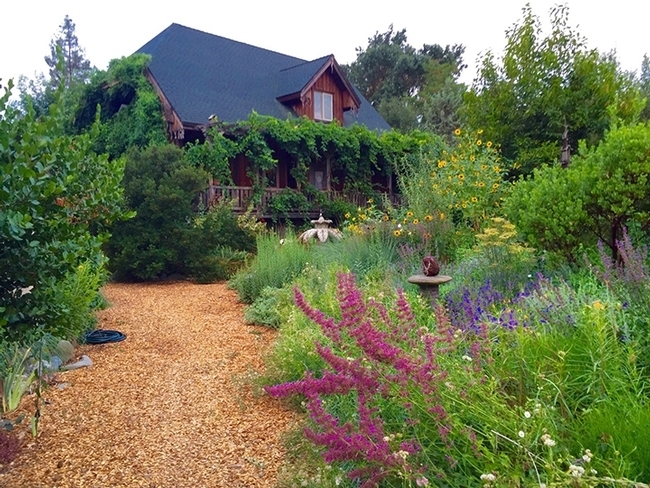
The garden of Kate and Ben Frey, Hopland, is a showstopper.